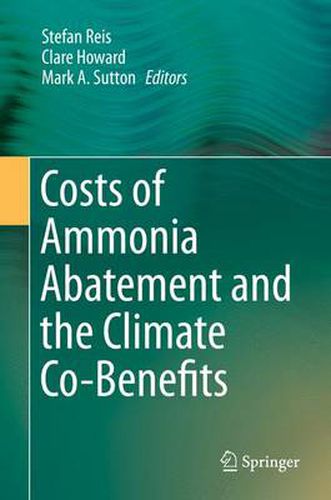Readings Newsletter
Become a Readings Member to make your shopping experience even easier.
Sign in or sign up for free!
You’re not far away from qualifying for FREE standard shipping within Australia
You’ve qualified for FREE standard shipping within Australia
The cart is loading…






This title is printed to order. This book may have been self-published. If so, we cannot guarantee the quality of the content. In the main most books will have gone through the editing process however some may not. We therefore suggest that you be aware of this before ordering this book. If in doubt check either the author or publisher’s details as we are unable to accept any returns unless they are faulty. Please contact us if you have any questions.
This book examines the costs involved in reducing ammonia emissions from agricultural practices as well as the potential benefits for climate change mitigation. It features contributions by experts in agricultural production processes, producers of agricultural equipment and service providers as well as scientists who assess the issue from an European perspective.
Coverage examines all agricultural production stages starting from animal feed and housing, including the storage and application of liquid and solid manure and of mineral fertilizer. In addition, the book looks at the relationship between ammonia control and greenhouse gas emissions and details the GAINS (Greenhouse Gas and Air Pollution Interactions and Synergies) model for estimating costs and reducing ammonia emissions from agriculture. Examples and case studies from select European countries, including Italy, Switzerland, Russia, Ireland, and Spain, provide readers with detailed studies of ammonia abatement costs and the effectiveness of implementing control measures under different conditions. This book is the result of an Expert Workshop held under the auspices of the UNECE Convention on Long-range Transboundary Air Pollution (CLRTAP) and organised by the Task Force on Reactive Nitrogen (TFRN). The findings of this workshop have informed the development of documents supporting the revision of the Gothenburg Protocol and provided researchers and practitioners with vital new data. Bringing together a wealth of key information on the costs of ammonia abatement and the climate co-benefits, this monograph provides readers with deep insight into this complex issue.
$9.00 standard shipping within Australia
FREE standard shipping within Australia for orders over $100.00
Express & International shipping calculated at checkout
This title is printed to order. This book may have been self-published. If so, we cannot guarantee the quality of the content. In the main most books will have gone through the editing process however some may not. We therefore suggest that you be aware of this before ordering this book. If in doubt check either the author or publisher’s details as we are unable to accept any returns unless they are faulty. Please contact us if you have any questions.
This book examines the costs involved in reducing ammonia emissions from agricultural practices as well as the potential benefits for climate change mitigation. It features contributions by experts in agricultural production processes, producers of agricultural equipment and service providers as well as scientists who assess the issue from an European perspective.
Coverage examines all agricultural production stages starting from animal feed and housing, including the storage and application of liquid and solid manure and of mineral fertilizer. In addition, the book looks at the relationship between ammonia control and greenhouse gas emissions and details the GAINS (Greenhouse Gas and Air Pollution Interactions and Synergies) model for estimating costs and reducing ammonia emissions from agriculture. Examples and case studies from select European countries, including Italy, Switzerland, Russia, Ireland, and Spain, provide readers with detailed studies of ammonia abatement costs and the effectiveness of implementing control measures under different conditions. This book is the result of an Expert Workshop held under the auspices of the UNECE Convention on Long-range Transboundary Air Pollution (CLRTAP) and organised by the Task Force on Reactive Nitrogen (TFRN). The findings of this workshop have informed the development of documents supporting the revision of the Gothenburg Protocol and provided researchers and practitioners with vital new data. Bringing together a wealth of key information on the costs of ammonia abatement and the climate co-benefits, this monograph provides readers with deep insight into this complex issue.